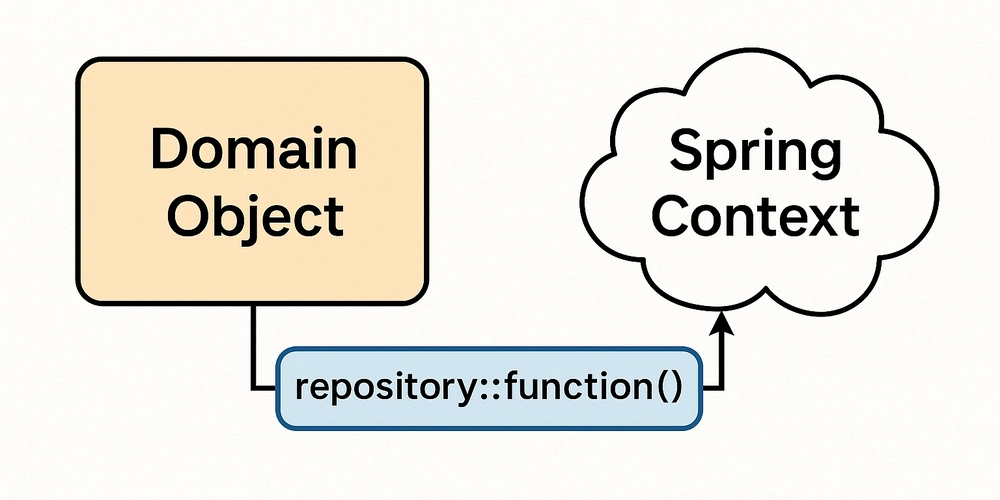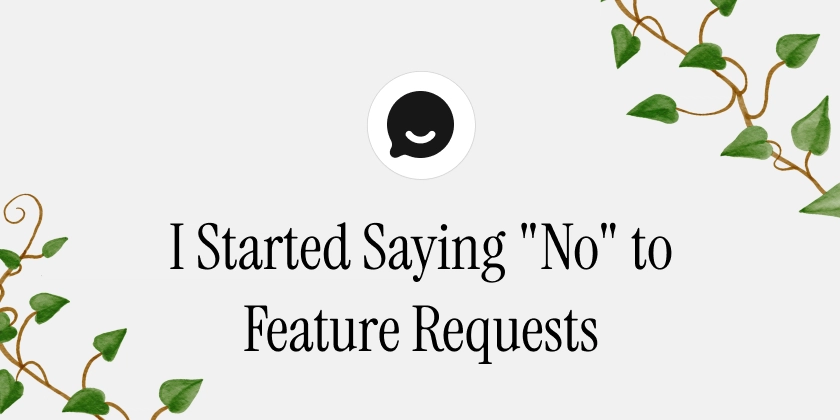DDD-like Kotlin object cooperating with Spring context
My friend Dominik helped me figure out which direction to take my coding skills. I never really liked the standard industry patterns that come with the Spring framework, where code is split into APIs, services, and repositories communicating via DTOs, DAOs, etc. I missed encapsulation and clear business objects. Plus, I enjoy both functional and OOP programming, and this layered approach often goes against those principles. DDD is full of abstract rules, but I decided to follow two simple ones: Domain objects are created on the edge of the domain layer or from another domain object. A domain object is a real object — it contains both data and business logic. Kotlin implementation Sticking to this leads to fluent, readable code that's easy to test and keeps domain problems well-encapsulated. Unfortunately, the Spring framework doesn’t really support this approach by default — it manages beans and stores them in the application context. So the question became: how can I keep clean, OOP-style domain objects while still calling functions that rely on the application context, like opening a DB transaction? The example below shows that if a function from a bean (usually a repository) is passed into a domain object as a lambda, the Spring context remains available — and even Spring aspects continue to work as expected. // GraphQl endpoint and edge of a domain layer @DgsComponent class DeleteCertificateMutation( private val certificateDbAdapter: CertificateDbAdapter, private val validator: DomainValidator, ) { @DgsMutation suspend fun deleteCertificate(id: String): Boolean = validator.existsCertificate(id) .deleteCertificate( certificateDbAdapter::deleteCertificate, ).getOrThrow() } // Snipped from Certificate domain object open suspend fun deleteCertificate( deleteCertificate: suspend (CertificateId) -> Unit, getSupplier: suspend (CertificateId) -> SupplierId, ): Either { // some business logic before like checking right etc. deleteCertificate(this@CertificateId).run { supplier.recalculateStatus() } true } Of course, there are also ways to avoid relying on the Spring context between the domain and repository layers, but in my case, I needed to use Spring Data R2DBC — probably the only reactive SQL database library that supports transactions — and it relies on aspects. Conclusion This approach allows you to have clean, OOP-style domain objects without losing the benefits of the Spring Framework environment. Domain objects are easy to unit test without needing mocking frameworks — which often lead to brittle tests focused too much on implementation details. To save time, I still use mock() for method or constructor arguments that aren't relevant to the test itself.

My friend Dominik helped me figure out which direction to take my coding skills. I never really liked the standard industry patterns that come with the Spring framework, where code is split into APIs, services, and repositories communicating via DTOs, DAOs, etc. I missed encapsulation and clear business objects. Plus, I enjoy both functional and OOP programming, and this layered approach often goes against those principles. DDD is full of abstract rules, but I decided to follow two simple ones:
- Domain objects are created on the edge of the domain layer or from another domain object.
- A domain object is a real object — it contains both data and business logic.
Kotlin implementation
Sticking to this leads to fluent, readable code that's easy to test and keeps domain problems well-encapsulated. Unfortunately, the Spring framework doesn’t really support this approach by default — it manages beans and stores them in the application context. So the question became: how can I keep clean, OOP-style domain objects while still calling functions that rely on the application context, like opening a DB transaction?
The example below shows that if a function from a bean (usually a repository) is passed into a domain object as a lambda, the Spring context remains available — and even Spring aspects continue to work as expected.
// GraphQl endpoint and edge of a domain layer
@DgsComponent
class DeleteCertificateMutation(
private val certificateDbAdapter: CertificateDbAdapter,
private val validator: DomainValidator,
) {
@DgsMutation
suspend fun deleteCertificate(id: String): Boolean =
validator.existsCertificate(id)
.deleteCertificate(
certificateDbAdapter::deleteCertificate,
).getOrThrow()
}
// Snipped from Certificate domain object
open suspend fun deleteCertificate(
deleteCertificate: suspend (CertificateId) -> Unit,
getSupplier: suspend (CertificateId) -> SupplierId,
): Either<NotAdminError, Boolean> {
// some business logic before like checking right etc.
deleteCertificate(this@CertificateId).run
{ supplier.recalculateStatus() }
true
}
Of course, there are also ways to avoid relying on the Spring context between the domain and repository layers, but in my case, I needed to use Spring Data R2DBC — probably the only reactive SQL database library that supports transactions — and it relies on aspects.
Conclusion
- This approach allows you to have clean, OOP-style domain objects without losing the benefits of the Spring Framework environment.
- Domain objects are easy to unit test without needing mocking frameworks — which often lead to brittle tests focused too much on implementation details.
- To save time, I still use mock() for method or constructor arguments that aren't relevant to the test itself.









































































































































































![[The AI Show Episode 144]: ChatGPT’s New Memory, Shopify CEO’s Leaked “AI First” Memo, Google Cloud Next Releases, o3 and o4-mini Coming Soon & Llama 4’s Rocky Launch](https://www.marketingaiinstitute.com/hubfs/ep%20144%20cover.png)




























































































































![[DEALS] The All-in-One Microsoft Office Pro 2019 for Windows: Lifetime License + Windows 11 Pro Bundle (89% off) & Other Deals Up To 98% Off](https://www.javacodegeeks.com/wp-content/uploads/2012/12/jcg-logo.jpg)



























![Is this too much for a modular monolith system? [closed]](https://i.sstatic.net/pYL1nsfg.png)






















































































































_Andreas_Prott_Alamy.jpg?width=1280&auto=webp&quality=80&disable=upscale#)
































































































![What features do you get with Gemini Advanced? [April 2025]](https://i0.wp.com/9to5google.com/wp-content/uploads/sites/4/2024/02/gemini-advanced-cover.jpg?resize=1200%2C628&quality=82&strip=all&ssl=1)













![Apple Shares Official Trailer for 'Long Way Home' Starring Ewan McGregor and Charley Boorman [Video]](https://www.iclarified.com/images/news/97069/97069/97069-640.jpg)
![Apple Watch Series 10 Back On Sale for $299! [Lowest Price Ever]](https://www.iclarified.com/images/news/96657/96657/96657-640.jpg)
![EU Postpones Apple App Store Fines Amid Tariff Negotiations [Report]](https://www.iclarified.com/images/news/97068/97068/97068-640.jpg)
![Apple Slips to Fifth in China's Smartphone Market with 9% Decline [Report]](https://www.iclarified.com/images/news/97065/97065/97065-640.jpg)




































































































































